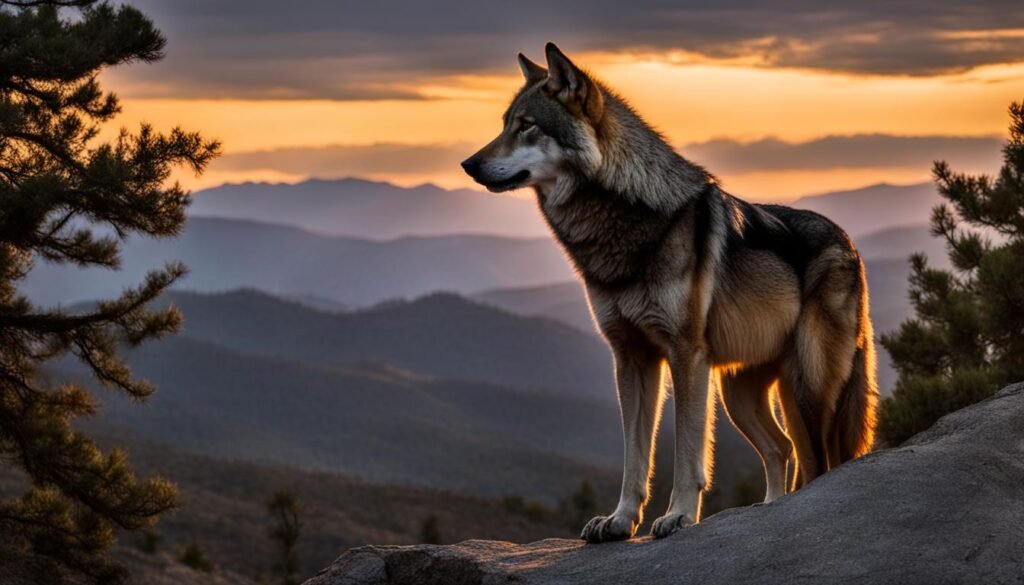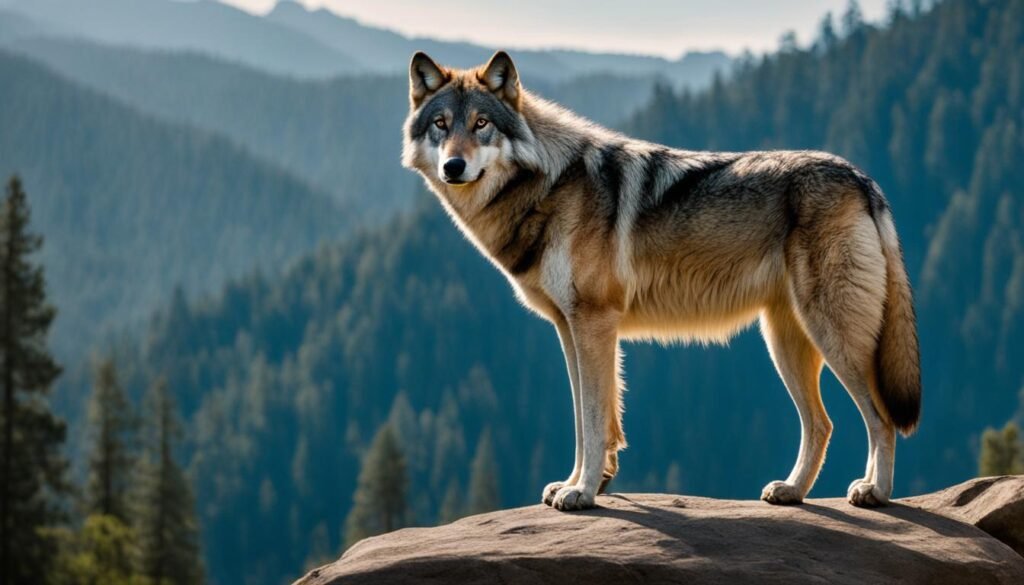Welcome to the world of California wolves! As a resident of the beautiful Golden State, I have had the privilege of witnessing the majesty of these incredible creatures in their natural habitat. California is home to a diverse population of wolves, including the iconic California gray wolf. In this article, I will share with you some fascinating facts about gray wolves in California, the efforts being made to conserve their populations, and tips on how we can coexist harmoniously with these magnificent animals.
Key Takeaways:
- The California Wolf Center actively participates in the conservation of wolves, particularly the Mexican gray wolf.
- Efforts are being made to increase the genetic diversity of the critically endangered Mexican gray wolf for reintroduction to the wild.
- The center supports every wild Mexican gray wolf pack in the United States through their Mexican Wolf Conservation Program.
- Coexistence strategies, such as non-lethal deterrents and better animal husbandry practices, are being promoted to reduce conflicts between wolves and human activities.
- Protecting and restoring wolf populations is crucial for the overall health of California’s wildlife and ecosystems.
The Importance of Wolf Conservation
Wolves are vital for maintaining the balance and health of ecosystems. These majestic creatures play a crucial role in regulating the populations of prey species such as deer and elk, which in turn has a positive impact on other plant and animal species. Additionally, wolves contribute to nutrient cycling through the carcasses of their prey, providing food for scavengers and redistributing essential nutrients in the environment.
The conservation of wolves is of utmost importance as it directly affects biodiversity and the overall ecological equilibrium. California is home to endangered wolf species, including the gray wolf (Canis lupus), making efforts to protect and restore their populations crucial for the state’s wildlife.


By safeguarding wolf populations, we contribute to the preservation of the delicate web of life in California. The recovery of these endangered wolves strengthens the state’s natural heritage and ensures the sustainable existence of various plant and animal species that rely on healthy ecosystems.
Coexistence with Wolves
Coexistence between humans and wolves is an essential aspect of wolf conservation. At the California Wolf Center, we actively collaborate with ranchers and producers in the Southwest to promote effective coexistence strategies. These strategies aim to minimize conflicts between wolves and human activities, allowing for the long-term survival of these magnificent creatures.
One of the key approaches we advocate for is the use of non-lethal deterrents. These include turbo-fladry, which is a type of flagging system that creates a visual barrier to discourage wolves from approaching livestock, and livestock guardian dogs, which help protect livestock by warding off potential predators. By employing these non-lethal methods, we can create a safe environment for both wolves and livestock.
Furthermore, we emphasize the importance of implementing better animal husbandry practices. By improving livestock management techniques, such as secure enclosures for livestock and proper disposal of carcasses, we can reduce the likelihood of interactions between wolves and domestic animals.
The California Wolf Center also supports the reintroduction of wolves into suitable habitats. This involves identifying areas where the wolf population can thrive and ensuring a successful reintroduction process. By reintroducing wolves to their natural habitats, we contribute to the restoration and preservation of ecological balance.
We believe that public outreach and education are vital for raising awareness about the conservation of wolves. By engaging with communities and sharing information about the ecological importance of wolves, we can foster a sense of coexistence and understanding. Through our educational programs and public events, we aim to inspire individuals to become advocates for wolf conservation and actively participate in efforts to protect these incredible animals.
By promoting coexistence, implementing non-lethal deterrents, supporting reintroduction efforts, and raising awareness, we can ensure the successful conservation of wolves in California. Together, we can protect these iconic creatures and preserve the unique wildlife diversity of the state.
The Importance of Wolf Protection
Wolves are considered an endangered species in California, and their protection is crucial for their survival and the preservation of the state’s biodiversity. The loss of habitat and historical persecution of wolves have led to their decline in many areas. Despite the progress made in reintroducing wolves to certain regions, there are still threats to their populations.
Recently, the U.S. Fish and Wildlife Service removed federal Endangered Species Act protections for gray wolves in most of the Lower 48 states. However, a judge’s ruling has temporarily restored these protections. Ongoing efforts to protect wolves and their habitats are essential to ensure their long-term survival.


Conservation organizations and wildlife agencies play a vital role in the conservation of wolves. They work tirelessly to monitor wolf populations, educate the public about wolf conservation, and implement strategies to mitigate human-wolf conflicts.
Wolf Facts:
- Wolves are highly social animals, living in packs that consist of a dominant breeding pair and their offspring.
- They communicate through vocalizations such as howls and body language.
- Wolves are skilled hunters and mainly feed on large herbivores like deer and elk.
- They have a keen sense of smell, hearing, and sight, which aids them in hunting and navigating their surroundings.
- California has witnessed occasional wolf sightings, indicating the potential for wolf populations to thrive in suitable habitats.
By protecting wolves and their habitats, we not only ensure the survival of an iconic species but also contribute to the overall health and balance of California’s ecosystems.
Conclusion
Conserving and coexisting with wolves in California is a complex and ongoing process. Organizations like the California Wolf Center play a crucial role in breeding and reintroducing wolves to the wild, working with ranchers to develop coexistence strategies, and advocating for wolf protection. It’s important for individuals to support these conservation efforts through donations, memberships, and spreading accurate information about wolves. By working together, we can ensure the continued existence of wolves in California and foster a harmonious relationship between humans and these magnificent creatures.
FAQ
Are there wolves in California?
Yes, there are wolves in California. The state is home to endangered wolf species, including the gray wolf.
What is the California Wolf Center?
The California Wolf Center is actively involved in wolf conservation, particularly the Mexican gray wolf. They are part of a captive breeding program called the Species Survival Plan and work towards increasing the genetic diversity of the critically endangered Mexican gray wolf for reintroduction to the wild.
How does the California Wolf Center support wolf recovery?
The California Wolf Center has a Mexican Wolf Conservation Program that supports every wild Mexican gray wolf pack in the United States. They work with nonprofit partners and government agencies to promote wolf recovery through initiatives such as cross-fostering, range riders, and field volunteers.
Do wolves play a crucial role in ecosystems?
Yes, wolves play a crucial role in maintaining healthy ecosystems. They help regulate the populations of prey species like deer and elk, which benefits other plant and animal species. Wolves also contribute to nutrient cycling through the carcasses of their prey, providing food for scavengers and redistributing nutrients in the environment.
How does coexistence between humans and wolves contribute to wolf conservation?
Coexistence between humans and wolves is an important aspect of wolf conservation. The California Wolf Center actively works with ranchers and producers to promote coexistence strategies, including the use of non-lethal deterrents and the implementation of better animal husbandry practices, to minimize conflicts between wolves and human activities.
Why is wolf protection important?
Wolf protection is crucial for their survival and the preservation of biodiversity. Wolves have faced habitat loss and historical persecution, leading to their decline in many areas. Efforts to protect and restore wolf populations are necessary for the overall health of wildlife in California.
What are some of the ongoing efforts to conserve and protect wolves in California?
The California Wolf Center plays a crucial role in breeding and reintroducing wolves to the wild, working with ranchers to develop coexistence strategies, and advocating for wolf protection. Public support through donations, memberships, and spreading accurate information about wolves is also important for these conservation efforts.
How many institutions are participating in the Species Survival Plan?
The California Wolf Center is one of the largest breeding facilities out of the 60 participating institutions in the Species Survival Plan.
What is the goal of the captive breeding program?
The goal of the captive breeding program is to increase the genetic diversity of the critically endangered Mexican gray wolf for reintroduction to the wild.
What is cross-fostering?
Cross-fostering is an initiative in wolf recovery that involves placing wolf pups from captivity into wild wolf dens to be raised by the wild pack, increasing the number of viable pups in the wild.
Are gray wolves still protected under the Endangered Species Act in California?
While the U.S. Fish and Wildlife Service temporarily removed federal Endangered Species Act protections for gray wolves in most of the Lower 48 states, a judge’s ruling has restored these protections, including in California.









